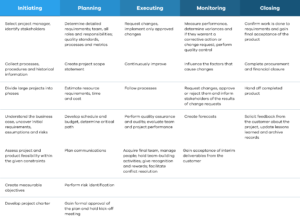
Managing Projects: our view on how to do it right
Managing projects is about getting everyone to work together
towards a common goal. This is how we make it happen.
Project management, or the process of managing projects, can take many paths; it all depends on what type of projects you manage, what kind of business you’re in, and the background of those involved. It is always complex, no matter what the scale or scope. Managing projects is such a challenge that despite decades of methodologies, advice and books, around 75% IT projects keep failing. Reasons range from a poorly defined scope to inadequate vision or excess complexity. There is a lot that can go wrong and it takes a very special person to keep it on the right track – the Project Manager.

Source: ProofHub
Check out the 8 IT project management skills you need to succeed.
A Project Manager needs a lot more than time management and people skills. A Project Manager is like a maestro, coordinating musicians playing various instruments, each with a specific purpose. Although there isn’t a specific formula, there are more some important guidelines to managing projects, especially in the Tech space. Let’s dig in!
Managing projects efficiently: our guide
A Project Manager is both a facilitator and communicator, ensuring everyone shares the same vision. But how can do Near Partner’s Project Managers juggle the demands of customers, team members, and different departments, while keeping the project development on the right track? We usually divide projects into 5 different and specific phases, which, all together, enable reaching success and client satisfaction.
From the PMP preparation guide, here’s what’s included in each phase and how we manage a project at Near Partner:

5 stages of a Project
Stage 1: Project Initiation
The first stage of managing projects is the project initiation, or conception. In this initial phase, the Project Manager defines, with all main stakeholders, the actual scope, with a detailed analysis of all the variables involved. In short, this phase is the project foundation, where the following need to be considered:
- Scope of the project: meaning limits and boundaries, and objectives or goals.
- Overview: the overview considers the resources, the time limits, and the goals required to complete a project, including the KPIs to measure them.
- Budgets: budgeting is also included in this initial stage and should accommodate possible changes or problems within a reasonable margin.
If the project is quite complex or large, or both, we might need to create detailed documentation for this stage (also dubbed a project charter or project initiation documentation).
Stage 2: Project Planning
Once the project clears the initiation stage, there comes the planning stage. The project plan consists of:
- Selection of team members
- Resource estimation
- Prediction of dependencies
- Outline of deliverables
- Creation of roadmap
- Creation of a product backlog
- Planning of dates and milestones
Also in the planning stage, the Project Manager will choose and outline which project management method to follow, such as Waterfall, Scrum, Kanban, Lean, among others – but we’ll expand more on those later.
Now we are ready for a kick-off meeting!
Stage 3: Project Execution
Conception and planning are done, so it is time to execute. This execution phase usually starts with a meeting where team members are informed of their roles and responsibilities. The project execution is about getting things done, following (or adapting) the plan and meeting deadlines.
During the execution phase, the Project Manager is quite busy, managing all aspects of the project, such as workflows, changes, and corrective actions. This stage relies immensely on communication among team members, between different teams and departments, and also between all of the above and the Project Manager. Communication is one of our main skills and something we try to exercise like a muscle.
Check out our project management dream combination toolkit.
Stage 4: Project Monitoring and Controlling
The monitoring and control stage happens simultaneously with the execution. This stage focuses on performance, progression, status, budget, and schedule. More concretely, the Project Manager must be able to answer questions like “where are we in the project?”, “where should we be in the project, according to the roadmap?”, “how much is still to be done?”, “what are the issues encountered and why?”, “will we be able to meet X deadline?”, and “will the project be finished on time?”, among a myriad of others.
This monitoring can be done in many ways such as via regular project “check-ins” with teams or use of tracking tools and frameworks (Kanban boards for example, team stand-ups, etc). Essentially, we must be on top of key activities and take action should some problem arise. It also should be noted that communication and teamwork are key in this stage.
Stage 5: Project Closure
The final stage of the project management lifecycle is its Closure – also known as lessons learned or postmortem – and can be done through a retrospective. Here, the Project Manager must assess, with the team and main stakeholders, performance, what went well and what could have been done better, maintaining important records, templates and documentation. Last but not least, celebrating the success of the project.
Included in the Project Closure is the “project delivery”, that means all activities are wrapped up and the final product is delivered. The Project Manager presents this document to a client, an internal team or department, or an external stakeholder.
Depending on the project and on the project management style, there might be the need for concluding any formal contracts or agreements, as well as for conducting a final audit of the project.
This is how we carried out a project that filled a technological gap within QMC and brought about a cultural change.
Project Management methodologies
Aside from the five stages of project management, there are several project management styles or methodologies. These are ways of organizing project development cycle using certain sets of principles, guidelines, tools, or communication channels, that meet the client’s requirements.
Some of the most popular project management methodologies that we are fans of:
Agile
If you have been following us for a while, you know we use Agile quite often. It is a flexible and people-centred approach to project management. It is usually deployed in software development, using an iterative style. Projects benefit from an Agile methodology when they require the client to take an active part in the development, when the scope is not well defined and to adapt to changes more easily.
There are several practices that fall under the Agile methodology, such as Scrum, Kanban, Lean, and XP.
- Scrum: suited for fast-paced and independent team-driven projects
- Kanban: for transparent and highly organised workload-driven projects (ex. manutention projects)
- Extreme Programming (XP): for productivity-driven projects requiring fast and continuous workflow.
- Lean: for resource-driven projects
Waterfall
The Waterfall methodology can be seen as the opposite of Agile. The Waterfall is the traditional project management technique that is characterised by its linear and sequential nature. It is plan-driven, as opposed to Agile’s change-drive, and is most beneficial for small projects with extensive documentation (requirements definition). In the Waterfall method, quality is prioritised over speed.
Critical Path Method (CPM)
The CPM is detailed and dependency-oriented, for time-driven projects, that are complicated and have many mutually dependent elements. In essence, the CPM can be compared to the Waterfall, with the difference that this method recognises dependencies. A dependency is a task that must be completed before another task can move forward, thus creating a critical path.
The main objective of CPM is to find the path having the biggest duration, and then the most critical, as if a step of this process gets delayed, it will delay the main delivery date. I wouldn’t say it’s a methodology but a tool or a step in a project, principally in project planning.
Critical Chain Project Management (CCPM)
The CCPM is an alternative to the CPM, as it focuses not on time but on the resources (human, hardware, equipment, etc) available for the project. This means that under the CCPM method, the focus is on critical tasks, there is no multitasking, and the time allocated to each project stage is estimated based on 100% workload, which in turn means, there will be no dead time.
Hybrid Methods
Since the whole point of managing projects is to do it efficiently, there are always ways to enhance a particular project management method, namely by cherry-picking what works from a particular model and adding it to another general model. Examples of Hybrid Methods are the Agile+Waterfall method, the Scrumban (Scrum+Kanban – check a detailed comparison Scrum vs Kanban), the CCPM+Agile hybrid, and more. Hybrid methods can be extremely useful, depending on the project, since they can be perfectly tailored to a team or project.
Managing projects with Near Partner
The work of a Project Manager is no walk in the park, more like a trek under unpredictable conditions. What would be of an orchestra without its maestro? So, it is important to make sure your teams have strong guidance and a solid project plan or roadmap to follow.
With this in mind, many businesses opt for extended teams, which not only help complete the projects that will jumpstart the business, but also train their in-house teams. Our amazing team of 30+ developers has the experience, the expertise, and the motivation that your business needs to get that project off the ground. Not sure how Near Partner can help you and your business?
Get in touch with Near Partner, and let us work together to bring your vision to life.




